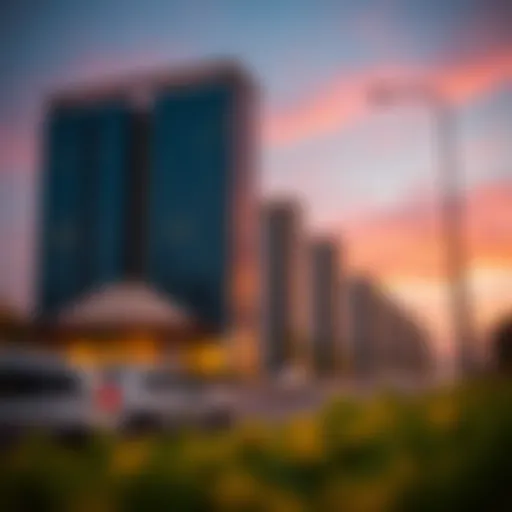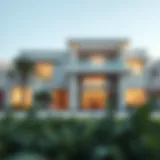Dubai National Insurance Building: Architecture & Economy
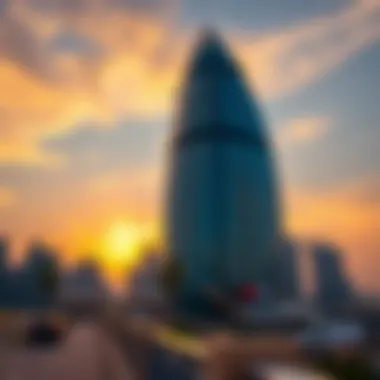

Intro
The Dubai National Insurance Building stands as a testament to the rapid transformation of the city of Dubai. With its striking design and pivotal role within the local landscape, this structure is more than just a building—it embodies the aspirations of a burgeoning metropolis. In examining the architectural features and economic implications of the building, the article aims to paint a detailed picture of its significance.
As one navigates through the various facets of this structure, it's essential to consider its architectural prowess, which has become a marker of progress for Dubai. The building is not only a hub for the insurance and financial sectors but also contributes to shaping the skyline that attracts both investors and expatriates.
Through meticulous analysis, the exploration will cover everything from the building's history and design characteristics to its broader impact on the market trends and future investment opportunities. This both equips potential investors with key insights and offers a substantial understanding of how the Dubai National Insurance Building fits into the larger narrative of commercial real estate in Dubai.
Market Trends
Understanding the current market trends surrounding the Dubai National Insurance Building highlights its importance in the broader context of the city's economic health. Investors and real estate agents alike are keen to gauge how this prominent structure affects the local market dynamics.
Current Market Analysis
Currently, Dubai's real estate market is experiencing a resurgence, fueled by both foreign investment and renewed interest from local buyers. The insurance sector, represented by this key building, plays a crucial role in the economic fabric of the city. Here are some critical factors influencing the market:
- Increased Demand for Office Spaces: With businesses returning to a more normal operating rhythm post-pandemic, there’s been an uptick in demand for premium office space, strategically exemplified by the Dubai National Insurance Building.
- Financial Services Growth: As Dubai positions itself as a leading financial hub in the Middle East, buildings like these cater to a burgeoning industry that is attracting talent and enterprise.
- Regulatory Environment: Changes in laws that facilitate property ownership and investment for foreign nationals are enticing more players to the market.
“The Dubai National Insurance Building is a key player in the real estate scene, acting as a beacon of opportunity and growth.”
Future Predictions
Looking ahead, there are several potential trends worth considering:
- Sustainability Concerns: As the building continues to be a prime location, emphasis on green building practices and sustainability will likely shape future developments in the vicinity.
- Technological Advancements: Smarter building infrastructures adapting to modern workplace needs can redefine the attractiveness of such properties.
- Integrating Mixed-Use Developments: Future projects surrounding the building may increasingly incorporate mixed-use functionalities to enhance community engagement and economic viability.
Investment Insights
Investors eyeing the Dubai real estate market should consider several factors when assessing opportunities associated with the Dubai National Insurance Building.
Best Areas for Investment
With the insurance sector as a foundation, certain areas remain consistently attractive for investment, including:
- Downtown Dubai: Renowned for luxurious living and business opportunities.
- Dubai International Financial Centre (DIFC): The financial heart of Dubai, offering premium commercial space.
- Business Bay: This area is continually evolving and showing great potential for returns.
Tips for First-Time Investors
For those venturing into the real estate market here, practical steps can make a significant difference:
- Do Your Homework: Conduct thorough research on the market trends and sectors you’re interested in.
- Seek Local Expertise: Collaborating with local real estate agents or firms can provide invaluable insights.
- Think Long-Term: While Dubai's market is enticing, a long-term perspective often yields better results than quick flips.
By synthesizing the intricate relationship between architecture, economics, and investment in the context of the Dubai National Insurance Building, this article aims to equip investors, agents, and homeowners with essential knowledge to navigate this dynamic landscape.
For more information on the evolving nature of Dubai’s real estate market, visit Wikipedia and Britannica.
Prelude to the Dubai National Insurance Building
The Dubai National Insurance Building stands as a notable landmark, representing not just a refinement in architecture but also the broader economic fabric of Dubai. Understanding this building is crucial for grasping how corporate edifices shape city landscapes, influence local economies, and establish a cultural identity. As investors, agents, expatriates, and homeowners navigate the real estate landscape of Dubai, the relevance of this architectural marvel comes into sharp focus.
Architectural Significance
Positioned strategically within the financial district, this building is a testament to modern design. Unlike many other structures in Dubai that flaunt exaggerated aesthetics, this one strikes a balance of function and form. The iconic facade and meticulous structural details reflect how architecture can enhance a city's skyline while serving practical business needs. Its design elements are imbued with the aspirations of a city that aims not just to excel but to stand out on a global stage.
Economic Influence
From an economic standpoint, the Dubai National Insurance Building embodies its sector’s resilience and growth. It is more than a mere office complex; it has become a hub for insurance services, connecting clients with providers in a seamless blend of innovation and reliability. This central role contributes to a surge in local employment, job creation, and economic activity within the vicinity. Such dynamics are essential for investors seeking opportunities in Dubai’s ever-evolving market.
Considerations for Investors and Homeowners
For potential homeowners and property investors, understanding the nuances of the Dubai National Insurance Building's role can provide insightful perspectives. Its presence is not just about access to insurance services; it opens doors to networking and business collaborations. Local real estate trends heavily depend on such influential structures, as they often dictate property values in adjacent areas.
"The architectural designs and economic strategies intertwined within such buildings are pillars that support the growth of a city like Dubai."
Historical Context of the Building
Understanding the historical context of the Dubai National Insurance Building is crucial for any thorough examination of its architectural and economic significance. This building is not just a structure; it's a symbol of Dubai's rapid evolution from a modest trade hub to a global powerhouse. The timeline of its construction and the inspiration behind its design capture the essence of a city that has continuously redefined its identity in the face of dynamic economic shifts.
Construction Timeline


The construction of the Dubai National Insurance Building commenced in the early 1990s—a period marked by significant investment in infrastructure and real estate within the United Arab Emirates. The project was part of a broader initiative to modernize Dubai, turning it into a vibrant metropolis. After breaking ground in 1992, the building took approximately three years to complete, officially opening its doors in 1995. This timeline is not just about the act of building; it is a representation of ambition and foresight among investors and stakeholders who recognized the need for robust infrastructure to support the burgeoning insurance sector.
In terms of its architectural features, the construction timeline reflects a synthesis of local traditions and modern techniques. The project utilized innovative construction methods that were ahead of their time, which contributed significantly to the building's durability and aesthetic appeal. Over the years, the Dubai National Insurance Building has experienced various upgrades that underscore its importance in the urban fabric of the city.
Architectural Inspiration
The architectural inspiration for the Dubai National Insurance Building is drawn from both modernist and traditional design principles, creating a unique synthesis that resonates with the cultural heritage of Dubai. Architects aimed to design a building that not only served functional purposes but also told the story of the city’s transformation and aspirations.
The design features elements reminiscent of Islamic architecture, such as intricate geometric patterns and arched windows, yet these are melded with the sleek lines and glass façades characteristic of modern office buildings. It embodies a dialogue between the past and the future, making it a compelling landmark in Dubai��’s skyline.
Moreover, the inspiration extends beyond just aesthetics; the building was envisioned as a hub for the insurance sector, epitomizing security, stability, and growth. Its towering presence symbolizes Dubai's ambition to be at the forefront of global finance and commerce, reflecting the city’s identity and aspirations in a rapidly changing world.
The Dubai National Insurance Building is a testament to the city’s evolution, embodying dreams and ambitions through its architectural language.
In summary, considering the historical context of the Dubai National Insurance Building provides invaluable insight into its significance, framing it as more than an insurance office but as a beacon of economic growth and architectural evolution in the heart of Dubai.
Architectural Features of Dubai National Insurance Building
The architectural features of the Dubai National Insurance Building go beyond mere aesthetics; they reflect the ambitions and the economic mindset of Dubai itself. The building serves not only as a structure to house various offices and insurance companies but also as a critical node within Dubai’s growing urban landscape. This section dissects the immediate significance of its design elements, the materials used, and the sustainability initiatives that characterize this landmark.
Design Elements
When considering the design elements of the Dubai National Insurance Building, one is struck by the fusion of modernism with cultural motifs. This building isn’t just a boxy office space; it boasts sweeping curves and sharp angles that capture the spirit of innovation in Dubai. The facade features large glass panels that allow natural light to flood the interiors, creating a vibrant working environment. Additionally, the exterior is accented with intricate patterns that pay homage to traditional Arabic architecture, marrying the old and the new in a harmonious fashion.
"This structure manifests the soul of Dubai, where cultures mingle and progress flourishes."
The lobby is not merely functional; it's a statement piece with soaring ceilings that make you feel as if you’ve walked into a modern art gallery rather than a corporate building. Such thoughtful design reinforces the building's role as a hub for business, impressing clients and leaving a lasting impression.
Materials Used
The materials selected for the Dubai National Insurance Building contribute significantly to its durability and aesthetic appeal. Predominantly, high-quality steel and reinforced concrete provide a robust framework capable of withstanding the various stresses posed by the environment. The glass used is not your run-of-the-mill variety; it’s treated for insulation and UV protection, ensuring the energy efficiency of the building.
Additionally, local stone is utilized in certain decorative aspects of the building. This choice is not only an homage to the geographical surroundings but also symbolizes a strong community relationship. By integrating local materials, the architects foster a sense of identity and belonging within the structure’s core.
Sustainability Initiatives
In an era where sustainability is no longer optional, the Dubai National Insurance Building takes its environmental responsibilities seriously. The building is equipped with advanced energy management systems aimed at reducing consumption. For instance, smart sensors adjust lighting and HVAC systems based on occupancy, which reduces energy waste without sacrificing comfort.
Moreover, the initiative to incorporate a green roof promotes biodiversity and aids in managing rainwater runoff—an often-overlooked aspect in urban areas. Such measures not only contribute positively to the building’s ecological footprint but also serve as a model for future developments in the region.
From careful design choices to innovative material use and sustainability efforts, the architectural features of the Dubai National Insurance Building illustrate a commitment to excellence and foresight. As Dubai continues to evolve, this building stands as a testament to both its architectural grace and economic significance.
The Building’s Role in Dubai's Economy
The Dubai National Insurance Building stands at a pivotal intersection of architecture and economics, encapsulating the dynamic evolution of Dubai’s commercial landscape. Functioning as a key player in the insurance sector, the building contributes significantly to the economic fabric of the region. This section analyzes how the building's presence influences the local economy, fosters employment opportunities, and impacts the broader economic indicators such as GDP.
Impact on the Insurance Sector
Nestled within the bustling heart of Dubai, the Dubai National Insurance Building is not merely a structure but a symbol of the city’s burgeoning insurance industry. Housing several leading insurance firms, the building has become a nexus for insurance-related activities, attracting both national and international players.
- Market Growth Catalyst: With its strategic location, the building serves as a base for innovative insurance products and services that respond to market demands. Businesses operating within its walls leverage networking opportunities, enhancing collaboration that can lead to new offerings and improved client services.
- Established Reputation: The presence of reputable insurers in the building reinforces Dubai's status as a global center for finance and commerce. This attraction of high-profile firms has a ripple effect, drawing in ancillary services like legal firms and consultancy agencies, which further fortify the sector's growth.
The building thus plays a critical role in shaping the market landscape, establishing a robust insurance ecosystem that fuels economic vitality.
Influence on Local Employment
The impact of the Dubai National Insurance Building extends beyond corporate profits; it is also a significant contributor to local employment. With numerous firms operating inside, the demand for skilled labor has surged, leading to a variety of job opportunities.
- Diverse Opportunities: The range of positions—from actuaries to customer service representatives—ensures that various skill sets are put to use. This is crucial in a city known for its economic diversity. Moreover, training programs initiated by companies foster upskilling, enhancing the talent pool.
- Indirect Employment: Beyond direct job creation, the building indirectly supports employment in surrounding businesses. Cafés, retail stores, and service providers experience increased foot traffic, leading to higher sales and job openings.
Overall, the structure acts as a magnet, attracting talent and contributing to a thriving job market in the vicinity.
Contribution to GDP
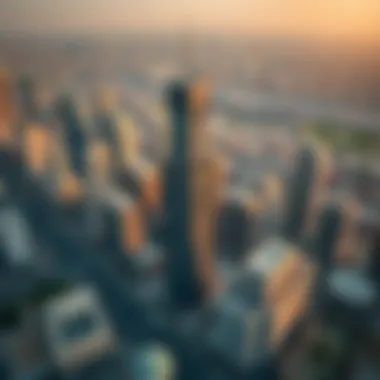

The role of the Dubai National Insurance Building transcends its immediate locality, significantly influencing the overall GDP of Dubai. As the insurance sector continues to grow, so too does its contribution to the economy.
- Economic Multiplier Effect: The activities housed within the building generate considerable economic output. Revenue from insurance premiums alone adds substantial value to the local economy, resulting in increased government revenues through taxes and investments into public services.
- Promoting Economic Stability: A strong insurance sector enhances financial resilience across various industries, which is vital in a rapidly changing economic landscape. By mitigating risks through insurance coverage, businesses feel secure in their operations, fostering economic growth and stability.
Strategic Location Analysis
The strategic location of the Dubai National Insurance Building plays a pivotal role in maximizing its functionality and significance within the urban landscape of Dubai. This aspect not only enhances the building’s architectural prominence but also solidifies its position as a critical player in the local economy. A thorough evaluation of this location underscores its benefits while bringing to light critical considerations for businesses, investors, expatriates, and homeowners alike.
Proximity to Financial Districts
Being adjacent to the major financial districts, the Dubai National Insurance Building serves as a linchpin for the insurance and financial sectors. For stakeholders, this proximity cultivates a myriad of prospects:
- Networking Opportunities: The close-knit connections foster networking, where professionals can mingle, share insights, and strike business deals seamlessly.
- Client Accessibility: For companies, having clients in proximity means easier access for meetings, consultations, and maintaining relationships.
- Business Competitiveness: The building’s location makes it an attractive site for firms within the insurance sector, enhancing their visibility and competitiveness.
Moreover, this strategic positioning allows for quick responses to market dynamics while being at the heart of financial decision-making processes. Firms aiming to establish themselves in Dubai find such locales invaluable for securing a foothold in the market.
Access to Transportation Networks
The Dubai National Insurance Building enjoys robust access to a well-structured transportation network, greatly contributing to its operational efficiency. This aspect is vital for both everyday business functions and overall enhancement of the local economy:
- Road Connectivity: Accessible main roads leading to and from the building support efficient vehicle movement, reducing transport time for employees and visitors alike.
- Public Transportation: Nearby metro stations and bus routes provide convenient options for commuting, elevating the building’s appeal. Less reliance on personal vehicles means fewer headaches during peak traffic hours.
- Logistics and Supply Chain: Enhanced transport links facilitate smoother logistics and supply chain operations, which is critical for businesses dealing in imports, exports, and services.
In addition, easy access to transportation not only aids existing businesses in the area but also attracts new establishments looking for a location that supports growth and connectivity.
"Strategic location is not just about geography; it intertwines with governance and dynamics of business interactions, creating an ecosystem for growth."
Opting for a location rich in these transportation networks and close to financial hubs positions the Dubai National Insurance Building as more than just an architectural landmark, but as a thriving nucleus for economic activity in Dubai.
Surrounding Developments and Urban Layout
The Dubai National Insurance Building stands as more than just a structure; it is a testament to the city’s continuous evolution and its strategic foresight. The urban layout surrounding this building is critical, as it reflects a blend of modernity and functionality that resonates with Dubai's ambitions. In this section, we'll unpack the various elements that accentuate the importance of developments around the building, showcasing both the benefits and the strategic considerations that come into play.
Effect on Neighboring Properties
The influence of the Dubai National Insurance Building on neighboring properties is profound. Its presence can create a domino effect that encourages neighboring landowners to elevate their developments to match the aesthetic or functional appeal of the building itself. This phenomenon often enhances property values. For instance, the query of whether property prices increase in proximity to landmark structures like this insurance building isn’t just anecdotal — studies show that they do. Potential buyers and investors seek spaces near high-profile developments, believing that these areas suggest safety and prosperity.
- Gentrification: As new businesses crop up around the insurance building, older properties may witness a rise in demand, leading to renovations and increased rents. This process might drive out long-term residents but could undoubtedly lead to a bustling neighborhood filled with vibrant commercial activity.
- Mixed-Use Spaces: Developments sprouting up nearby may also shift towards mixed-use models, accommodating both residential and commercial needs. The convenience of having insurance services, financial institutions, and recreational spaces nearby cannot be overstated, as it caters to the evolving lifestyles of expatriates and locals alike.
Such transformations rarely come without challenges. For existing residents, the influx of new businesses and higher rents may lead to discontent, creating disparities in the community. However, managed well, this can lead to a more dynamic urban environment benefiting all stakeholders.
“The intersection of business and community creates a lively urban atmosphere; the Dubai National Insurance Building is a cornerstone in this mosaic.”
Integration into Urban Master Plan
This building isn't a standalone landmark; it plays a vital role in the broader urban master plan of Dubai. The city’s leaders have always envisioned a skyline where each structure contributes uniquely to the whole. Thus, incorporating the insurance building into this plan wasn’t merely a matter of placing another skyscraper in the cityscape; it was an exercise in strategic placement and connectivity.
- Zoning Regulations: The building’s placement adheres to stringent zoning laws designed to optimize land use and encourage a balanced mix of business and residential areas. The thoughtful integration into the urban layout illustrates the meticulous planning that goes into architectural developments in Dubai.
- Transportation Accessibility: The coordination with transportation networks must not be overlooked. The building's strategic position near major transportation hubs allows for easy access for visitors and employees, enhancing the daily functioning of businesses housed within. This thoughtful design underscores Dubai’s commitment to a world-class city where mobility and accessibility drive economic activity.
- Green Spaces: Future developments in the vicinity are also expected to prioritize green spaces, further linking the urban setting with nature, allowing for outdoor leisure that enhances the quality of life.
Investors and developers looking at the impact of this building can find opportunities aligned with these urban goals. As more people flock to the area due to the benefits of proximity to established infrastructure, the scene at and around the Dubai National Insurance Building will continue to flourish, presenting a tapestry of investment prospects.
Future Trends for the Dubai National Insurance Building
The Dubai National Insurance Building stands at a critical juncture in its life, where discussions about future trends are not just whispers in the wind but pivotal points about its continued relevance in the fast-evolving urban landscape of Dubai. As the city forges ahead with ambitious developments, the future of this iconic building is interwoven with both physical renovations and the broader economic climate. Understanding these elements offers insightful perspectives for investors, agents, expatriates, and homeowners looking to capitalize on opportunities within the emirate.
Anticipated Renovations
Renovation of the Dubai National Insurance Building is not merely about cosmetic improvements; it signals a commitment to modernization while preserving its architectural integrity. Anticipated renovations focus on enhancing energy efficiency, improving facilities, and integrating contemporary technologies.
- Energy Efficiency Upgrades: In line with global trends, there’s a push toward greener buildings. The renovations may involve installing solar panels and upgrading insulation, thus reducing operational costs and enhancing sustainability.
- Internal Layout Reconfiguration: To meet the dynamic needs of modern businesses, there might be plans to redesign internal spaces. Moving towards open-plan environments can lead to increased collaboration and productivity.
- Smart Building Technologies: Technologies that improve the operational efficiency of buildings are gaining traction. The integration of smart systems like automated lighting and climate control can ensure a more responsive environment, important for attracting forward-thinking tenants.
These renovations are not without their challenges. Navigating regulatory requirements and managing the building's historical aspects while innovating will require deft project management and stakeholder engagement.
Potential for Mixed-Use Development
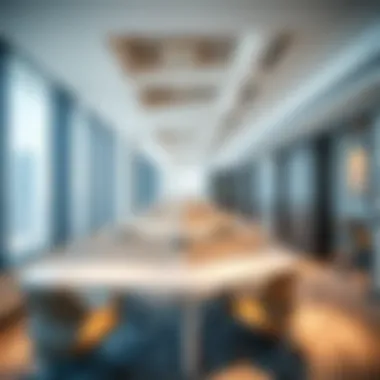

Another significant trend is the potential for mixed-use development around the Dubai National Insurance Building. This concept is becoming increasingly vital, as urban planners look to create livable spaces that blend commercial, residential, and recreational areas. The multifaceted approach has several benefits:
- Enhancing Property Value: Mixed-use developments tend to attract higher foot traffic, thereby increasing the value of the properties involved. Such transformation can lead to improved returns on investment for stakeholders.
- Community Engagement: By integrating residential options with business and leisure facilities, the building can serve as a community hub, fostering engagement among residents, workers, and visitors alike. An environment that combines living and working brings vibrancy to the area.
- Attracting Diverse Tenants: A mixed-use approach can attract a variety of tenants, from startups to well-established corporations, diversifying the building’s tenant base.
As developers consider the viability of mixed-use spaces, there are numerous factors to consider. Zoning regulations, community sentiment, and the demand for residential versus commercial space all come into play.
"The future of the Dubai National Insurance Building is not solely about its physical structure. It's a reflection of the city's broader ambitions to evolve into a vibrant, multifaceted urban environment."
Investment Opportunities Linked to the Building
The Dubai National Insurance Building serves as a focal point not only for the city's architectural landscape but also as a significant player in investment opportunities. As the dynamics of urban development continue to evolve in Dubai, understanding the potential tied to this building becomes essential for investors, agents, expatriates, and homeowners alike. The real estate market here is ever-changing, and the prospects linked to this specific building illustrate how crucial it can be when mapping out a successful investment strategy.
Commercial Leasing Potential
When delving into commercial leasing potential, the Dubai National Insurance Building stands out prominently. With its strategic location near major financial districts, it attracts numerous businesses seeking prime office space.
Several key aspects bolster its appeal in the commercial leasing sector:
- High Demand for Office Space: The influx of international companies setting up operations in Dubai has resulted in a burgeoning demand for quality office spaces. The Dubai National Insurance Building, with its modern facilities and aesthetic appeal, meets these demands effectively.
- Competitive Rental Rates: Compared to other properties in the vicinity, rentals in this building can often be competitive due to its comprehensive amenities and status. Investors can expect their properties here to remain in high demand, translating into less vacancy time.
- Enhanced Brand Representation: For businesses, being located in an iconic building lends a significant edge in brand representation. Associating with a well-regarded structure like the Dubai National Insurance Building allows companies to project an image of prestige and stability.
In essence, the commercial leasing scenario tied to this establishment not only presents secured cash flow opportunities for investors but also fortifies the overall economic landscape of the region through ongoing business activities.
Implications for Real Estate Investors
For real estate investors, the implications tied to the Dubai National Insurance Building are varied and substantial. This structure doesn't just contribute to immediate financial gains; rather, it forms a critical component of long-term investment strategies.
Considerations for real estate investors regarding this building include:
- Appreciation Potential: With Dubai’s continuous growth and development, properties within this urban hub, especially those like the Dubai National Insurance Building, are poised for significant appreciation over the years. Investors can anticipate value increases as the surrounding area continues to flourish.
- Diverse Tenant Profiles: Due to its multifaceted design and the variety of spaces available, the likelihood of attracting a diverse set of tenants—ranging from startups to established multinational corporations—enhances the sustainability of rental income.
- Resilience in Market Fluctuations: Real estate developments like this are often less impacted by market downturns due to their established relevance in the economic fabric of the city. Hence, investors can see it as a safe haven when broader market conditions become turbulent.
Community Impact and Corporate Social Responsibility
Community impact and corporate social responsibility (CSR) are significant facets of the Dubai National Insurance Building’s legacy and operation. CSR offers a framework for the building to engage with its environment and community effectively. By considering the social, economic, and environmental aspects of its initiatives, the building not only aims at business success but also seeks to enhance the quality of life for those in its vicinity.
One core area where the Dubai National Insurance Building demonstrates its commitment to the community is through local engagement initiatives. These initiatives foster a connection between the building and its surrounding area, ensuring that the facility is not just a transactional space but a community-centric hub. Programs can vary, from supporting local charities to enhancing cultural events that bring together various segments of the population. This engagement enriches the local fabric and strengthens ties, ultimately cultivating a sense of belonging among residents and businesses alike.
Local Engagement Initiatives
The building actively takes part in various local engagement initiatives aimed at uplifting the community. Collaborating with local charities and nonprofit organizations, the facility might host fundraising events, skill development workshops, or mentoring programs for youth. Such initiatives often allow professionals working in the building to share their expertise and provide invaluable insights to upcoming generations.
Moreover, fostering partnerships between businesses and local schools can create internship opportunities, allowing students to gain practical experience. When companies like those operating in the Dubai National Insurance Building embrace this model, it not only helps nurture local talent but engenders goodwill with the community.
“A community thrives when organizations take a vested interest in its growth and well-being.”
This perspective is essential, as the firm will often see returns on investment in the form of positive community sentiment, which can enhance brand reputation and customer loyalty.
Environmental Responsibility Efforts
Beyond community ties, the building also focuses on environmental responsibility. In a rapidly urbanizing Dubai, sustainability has taken a front seat in architectural practices. The Dubai National Insurance Building is keen on integrating eco-friendly practices in its operational processes. From energy-efficient systems, such as solar panels to rainwater harvesting methods, the initiatives taken here contribute substantively to reducing the overall carbon footprint.
Further commitment to sustainability can be observed through participation in city-wide green programs that aim to bolster environmental awareness among residents. This might include hosting workshops on waste management and recycling, thereby boosting community engagement on environmental issues.
Additionally, implementing green certifications for the building enhances its attractiveness to modern investors, who are increasingly looking for sustainable investment opportunities. These efforts are not merely altruistic; they serve as a savvy business strategy that can yield financial rewards alongside community and ecological benefits.
In summary, the Dubai National Insurance Building is not just an architectural marvel; it embodies the spirit of community and corporate responsibility. By prioritizing local engagement and environmental efforts, it manifests a holistic approach to corporate stewardship that resonates with its surroundings. Such dedication promotes a sustainable future, ensuring that the building stands as a beacon of progress in both economic and social realms.
Epilogue
In summarizing the architectural and economic significance of the Dubai National Insurance Building, it becomes clear just how pivotal this structure is within Dubai’s dynamic landscape. The building not only exemplifies modern design but also plays an integral role in the local economy. Its unique architectural features and strategic placement are contributing factors to its status as a hub for the insurance and financial sectors.
From an investment viewpoint, the building presents numerous opportunities. The growth and development surrounding it invigorate the real estate market and offer potential for high returns. Investors, whether they are seasoned or new to the market, should consider the implications of this building’s performance as an indicator of the broader trends within Dubai's economy.
Moreover, community engagement initiatives highlighted in this analysis emphasize the investment of the building's occupants in local welfare. This kind of corporate social responsibility can lead to sustained interest in the area, fostering long-term relationships between businesses and the community. It showcases a model where economic growth and social responsibility can coexist, leading to holistic development.
"The synergy between architecture and economy is not merely about buildings, but about creating environments that foster community and growth."
Finally, as Dubai continues to evolve, the Dubai National Insurance Building can be expected to adapt alongside urban trends and demands. Those interested in its prospects—be they agents, expatriates, or homeowners—will find that its influence on the skyline and the economy is likely to remain significant. Ultimately, this concludes an analysis that not only captures the essence of a building but also reflects the vibrancy of a city that continuously looks forward.



